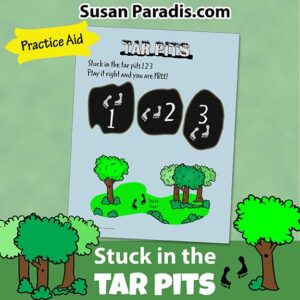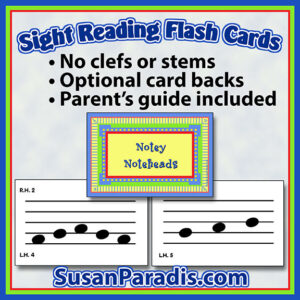Stuck in the Tar Pits
I received this email the other day. Susan, do you have any new material you will be using this fall that you can share with us?
The answer is, yes. Stuck in the Tar Pits is a new graphic that I designed and drew to teach students how to work on a difficult section, how to practice in small chunks, and how playing slowly will make it easier to learn a difficult section. As you know, young students have trouble with spot practicing. They prefer instead to practice by playing the piece over and over and going back to the beginning if they make a mistake, rather than just working on the problem measure.
This summer I visited the amazing tar pits in Los Angeles, and as usual, I thought of a way to not only share such a fascinating archaeological sight, but to tie it into piano lessons. Stuck in the Tar Pits is an idea that was inspired by Philip Johnston’s book, The Practice Revolution, that I reviewed last week.
I waited to use this when a student was having trouble with a short passage. I noticed he was starting to get frustrated, so I did what I usually do in this situation, changed the subject. I showed him a picture I took of the tar pits and how the prehistoric animals would get stuck in the tar, and now thousands of years later we can see their bones. He was too young to understand what tar is. I grew up getting tar on my shoes in the summer but we don’t use much tar here in Texas. It’s too hot, I guess. So we discussed how tar is sticky and gooey, and how the animals would get stuck in the tar. After a short discussion of ice age animals, we went back to the lesson.
The student, distracted from his frustration, was excited to try to get out of the tar pits. We put a tiny plastic tiger (pretending like it was a saber tooth tiger!) on the 1st black glob and the student played the measure that was giving him trouble. Oops, he played too fast and got it wrong, so we pretended like his little figure was stuck and he couldn’t move forward. On the second try he played a lot slower and it was correct, so he moved to #2, and then to #3, moving his little tiger along until he was in the grass. He discovered it wasn’t so hard after all once he relaxed and played slowly. I gave him a copy of Tar Pits to take home and use and I laminated one to use in my studio.
He learned a valuable lesson about practicing slowly and how to spot practice. On top of that, we had fun!




Thank you so much Susan! I used this yesterday with a few students who “got stuck in a tar pit.” They loved it! Even an 11 yr. old! BTW our Target store has a $1 Dinosaur play set in the dollar spot just inside the door! It is super cute and has a few dinos to choose from…and a cute tree that stands up!
What a fun idea! I love to think of fun games for repetition too. I have a bell collection that sits on my piano. When a student is having trouble with a passage, we play “The Bell Game.” I set out 5-6 bells. The student closes his eyes while I hide a sticker under one of them. Then he play the passage correctly and rings a bell. But if he doesn’t find the sticker under that bell, he must play the passage again. This continues until he finally uncovers the bell with the sticker hiding under it. My students LOVE this game.
I like to make connections to real life, also. See my blog post on “connections” at http://musicfortots.blogspot.com/
Thanks for your great ideas!
Wow, thanks Susan!
I’ve been doing the ‘three times in a row correct’ with my students for tricky bars/measures but don’t have anything as cool as this. I think the boys especially will love it.
…now to find my plastic dinosaurs and laminator 😀
Love it!
I couldn’t see where to say I ‘liked’ this blog, so I’m leaving a comment. What a great way to keep a student going and also to see things in a different light! Awesome
In order to “like” the post, you have to click on the post. You will see the “like” button a the bottom of the page.
So clever! I love how analogies and stories can make piano practicing so much more motivating for students. It makes me think of yesterday when I was teaching my young daughter the C pentascale. She was ready to quit until we started talking about “Hot Fudge Scales” and got her toy “Mother” to sit on the piano ledge and watch her play the keys.
Heidi,
That is the kind of thing I do all the time! It makes piano more fun and gets the point across.